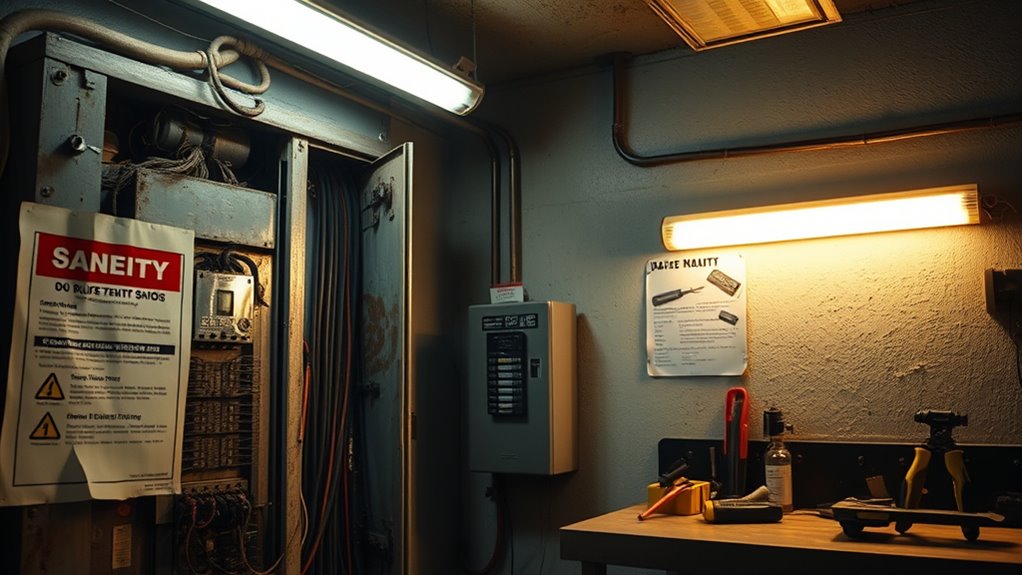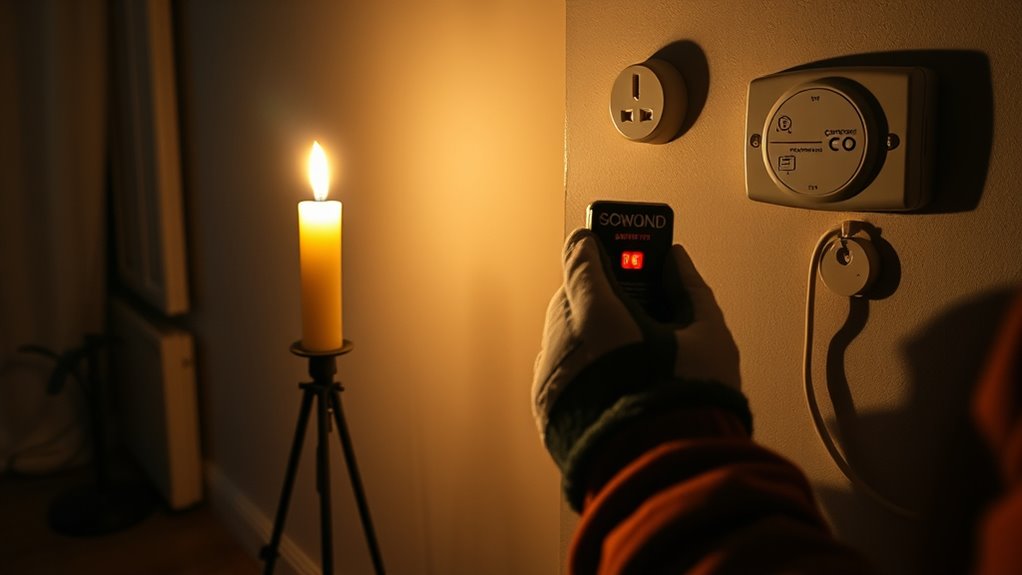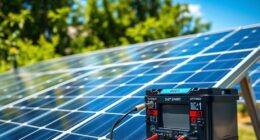During outages, do make certain your generator and appliances are placed outdoors, at least 20 feet from your home, following manufacturer instructions for ventilation. Never operate equipment in enclosed spaces, as this can cause dangerous carbon monoxide buildup. Regularly maintain your devices and watch for warning signs like strange odors or noises, which could signal issues. Sticking to these safety tips helps protect your family—continue on to learn more essential advice.
Key Takeaways
- Do operate generators outdoors, at least 20 feet from windows and vents; do not run them inside enclosed spaces.
- Do ensure proper ventilation and stable placement of appliances; do not position equipment on uneven or unstable surfaces.
- Do schedule regular maintenance checks; do not neglect upkeep, which can lead to dangerous malfunctions.
- Do watch for warning signs like unusual odors or noises; do not ignore these signs, as they may indicate CO risks.
- Do follow manufacturer instructions and safety guidelines; do not improvise or bypass recommended safety measures.
Do Use Proper Ventilation and Safe Equipment Placement

Proper ventilation and safe equipment placement are essential during outages to prevent carbon monoxide buildup and other hazards. Good air quality depends on ensuring that appliances like generators are positioned correctly and have adequate airflow. Keep generators outdoors, away from windows, doors, and vents, to prevent fumes from entering your home. Never operate equipment in enclosed spaces, as this considerably increases the risk of CO accumulation. Proper equipment positioning involves placing generators on level, stable surfaces, and maintaining at least 20 feet of distance from your home. Ventilation allows fresh air to circulate and disperse dangerous gases, reducing the chance of CO poisoning. Always follow manufacturer instructions for placement and ventilation to keep your environment safe during power outages. Factual safety guidelines are vital for protecting your household during such events.
Not Avoid Regular Maintenance and Ignoring Warning Signs

Neglecting regular maintenance and ignoring warning signs can lead to dangerous failures during outages. Skipping scheduled checks or dismissing warning signals puts your safety at risk and can cause catastrophic CO leaks. Proper maintenance scheduling ensures equipment functions correctly, while recognizing signs like unusual odors or inconsistent operation can prevent emergencies. Ignoring these cues forces you into reactive emergency procedures, which are riskier and less effective. Being aware of keto diet principles can help you stay vigilant about your health and safety in various situations.
Frequently Asked Questions
How Can I Tell if My CO Detector Is Functioning Properly?
You can tell if your CO detector is working by testing it regularly with the test button, which is part of proper CO detector maintenance. Also, replace the batteries annually and keep the detector clean. Be aware of symptoms of carbon monoxide poisoning, like headaches or dizziness, and have your detector inspected if it alarms or if you notice any issues. Regular testing guarantees your detector stays reliable in case of CO exposure.
What Are the Signs of CO Poisoning During an Outage?
If you experience symptoms like headache, dizziness, nausea, confusion, or weakness during an outage, it could be carbon monoxide poisoning. These symptoms are signs of carbon monoxide poisoning, so you should immediately move to fresh air and seek medical attention. To prevent poisoning, make certain your CO detectors are functioning properly and never use gas appliances or generators indoors during an outage. Stay alert to these signs to protect yourself and others.
Are Portable Generators Safe to Use Indoors?
Portable generators are not safe to use indoors because they produce carbon monoxide, a deadly gas. For indoor safety, never operate a generator inside your home, garage, or near vents. Always place your generator outdoors in a well-ventilated area, ideally away from windows and doors, to guarantee proper generator placement. This reduces the risk of CO buildup and keeps you and your family safe during power outages.
How Often Should I Test My CO Safety Equipment?
You should test your CO safety equipment at least once a month to guarantee proper detection. Did you know that carbon monoxide poisoning claims around 430 lives annually? Following a regular maintenance schedule helps keep your detectors sensitive and reliable. Use proper detection methods, like testing buttons and replacing batteries as needed. Consistent testing ensures early warning, giving you vital time to respond and stay safe during outages or emergencies.
What Should I Do if I Smell Gas During an Outage?
If you smell gas during an outage, act quickly. Ventilate the area by opening windows and doors, then leave the building immediately. Avoid using electrical switches or appliances that could ignite the gas. Remember, many carbon monoxide myths can lead to dangerous mistakes—don’t ignore the smell or assume it’s harmless. Prioritize emergency preparedness by knowing how to respond, ensuring everyone’s safety until professional help arrives.
Conclusion
Remember, staying safe during outages is all about good habits—you do the right things without thinking twice. As you carefully ventilate and position your equipment, it’s oddly reassuring how these small actions prevent bigger problems, almost like fate guiding you. Ignoring warning signs might seem harmless at first, but coincidence shows that regular maintenance and attention to detail keep everything running smoothly. Stay proactive, and safety will naturally follow—sometimes, it’s just a matter of paying attention when it counts most.









